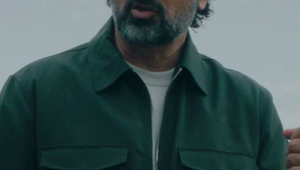
The Last Performance: What Made This Grand Prix Winning Spot So Special?

Special New Zealand’s campaign for Partners Life Life Insurance, ‘The Last Performance’, was one of the most decorated Australasia campaigns at last month's Cannes Lions Festival of Creativity.
For the spot, Special NZ took home a Gold, Silver, and Bronze Lion, as well as another Gold Lion for their collaboration with production company South Pacific Pictures. But most significantly, the campaign earned Special a Grand Prix for insurance advertising.
LBB’s Tom Loudon caught up with some of the campaign’s masterminds, Special NZ CSO Rory Gallery, and ECD Lisa Fedyszyn, to talk all things ‘The Last Performance’, and to learn what makes the spot so special.
LBB> Can you tell us about the inspiration behind ‘The Last Performance’ campaign, and how it challenges preconceptions around life insurance?
Rory> New Zealanders are chronically under-insured when it comes to life insurance. To give you a little sense of that, only 29% of New Zealanders have life insurance, as opposed to, say, 71% of Singaporeans. The brief to us was to encourage more New Zealanders to take an active interest in life insurance.
Lisa> Instead of treating the product like it was life insurance, we treated it like death insurance. Not being straight up about what the brand was selling wasn’t helping New Zealanders.
With ‘The Last Performance,’ we avoided overstating the benefit of ‘peace of mind’. And we embraced the honest reality of what we were selling.
LBB> Integrating the ads into the Kiwi whodunnit drama, The Brokenwood Mysteries, is a unique approach. What led to the decision to use this particular series for the campaign?
Lisa> The Brokenwood Mysteries is New Zealand’s most popular murder mystery series, in terms of reach, which was super helpful. There were six episodes in the season, so that meant six deaths and six perfect candidates to show why you should have life insurance through their hindsight.
The tone was really important as the show is a dark New Zealand comedy, which aligned with the Partners Life tone of voice. So it was an easy decision to use the series for the campaign.
LBB> How did you come up with the concept of bringing the dead characters back to life to convey the importance of life insurance?
Lisa> It was so clear to us that a dead person should be the spokesperson for life insurance. They really are the perfect people to talk about hindsight, and we actually couldn’t believe it hadn’t been done before. The answer had been under everyone’s noses all along: to use people in TV shows to advertise life insurance.
LBB> What were the main goals and objectives of the campaign? Did you achieve the desired impact in terms of raising awareness and encouraging action among New Zealanders?
Rory> Partners Life relies on an independent network of 1,700 advisors across the country to sell their insurance. The role that communications plays for Partners Life is to ensure that potential customers are aware of, and actively willing to consider, the brand when an advisor recommends them.
Partners Life sought to grow awareness and consideration by shining a light on a product that New Zealanders are chronically underinsured against – life insurance.
The campaign smashed all of its objectives. Brand awareness increased 29% - attaining the highest awareness score for Partners Life in the last three years. Consideration saw an uplift of 5%.More New Zealanders now see the value in the importance of having life insurance (12% uplift).
LBB> The Last Performance campaign won a Grand Prix in the Health and Wellness category at Cannes. Can you share your initial reactions and emotions when you found out about this prestigious award?
Lisa> Tears were the first reaction — a mix of surprise and exhaustion. We were so happy for the project, client, and team to receive this recognition after the years of hard work and perseverance that went into it.
Rory> This win was the start of a very big night. We work really hard to do the best work in the world, and to receive that recognition from our peers was just such an incredible honour.
LBB> The campaign aimed to disrupt standard advertising in the insurance industry. How did you ensure the message stood out and resonated with the target audience amid the clutter of other advertisements?
Rory> This was an ad, but it was masquerading as a TV show. By becoming part of the plot of a TV show, we were able to create something that just felt like it was part of the entertainment, rather than interrupting the content someone was already enjoying.
LBB> How did you collaborate with South Pacific Pictures to integrate the ads into a series? Can you elaborate on the level of collaboration and the challenges faced during the execution?
Lisa> Getting the TV show onboard with the idea was difficult. And to be fair, if you were a showrunner and you heard that an ad agency wanted to talk to you about a life insurance company infiltrating your storyline and using your characters, you would run a mile.
So we ensured the collaboration was beneficial to South Pacific Pictures, from using their director and crew, to creating additional talkability around the show, to most importantly, respectfully writing to the tone of voice of the characters and Brokenwood Mysteries.
And because of this successful collaboration, we were able to help a brand weave its way into the most unlikely of places – a primetime television show.
LBB> The Last Performance campaign tackles a topic that can be perceived as morbid or sensitive. How did you strike a balance between humour and conveying the importance of life insurance respectfully?
Lisa> Dead people are the perfect spokespeople to talk about regret and hindsight. And New Zealanders will engage with death when it’s not their own. True-crime podcasts, murder mysteries, and dark comedies are hugely popular genres in New Zealand. Humour and entertainment make the subject of death more palatable for New Zealanders.
To strike a balance between humour and conveying the importance of life insurance respectfully, we needed to be in places where death was ready to be received – a murder mystery that was also a dark comedy.
LBB> In what ways did the campaign impact Partners Life as a brand? Did it lead to an increase in inquiries or policy uptake?
Rory> Integrating our message into NZ’s most popular murder mystery show meant our message reached 59% of New Zealanders.
Overall, brand consideration went up 5%, brand awareness went up 6%, and appetite for life insurance rose 12%.
LBB> Looking back, what were some of the key learnings from the campaign?
Rory> Don’t just find the uncomfortable truth; confront it.
One of the things that's happened across my career is that we spend a lot of time in strategy, finding what the problem is in a category. But that often just acts as the context for creative work rather than being central to communications.
This campaign taught me that we should seek to confront the problems we find.
In confronting the uncomfortable subject of death head-on and in wrapping that discomfort in entertainment – Partners Life got more New Zealanders to willingly think about life insurance.
Lisa> The power of collaboration, because this is an idea that died and came back to life several times, and it took over two years to make. But the Last Performance kept being resuscitated because it had a passionate collaborative team around it keeping it alive. And I think, most importantly, we had an innovative client that believed in it and kept backing the idea. The entire agency, from account strategy, production and creative, all understood the power of this idea.
LBB> Is there anything you would have done differently?
Rory> Given this campaign is all about regrets in life, it feels appropriate to answer!
The Brokenwood Mysteries is a TV show that is present around the world. We came to an agreement with our client and the production company that we would onwards sell this idea around the world to other insurance companies (all they would have had to do is change the logo).
Unfortunately, because the season was rolling out, we just ran out of time to do this, which is a shame because if one other market had brought it, it would have essentially paid for the entire production of the campaign.















